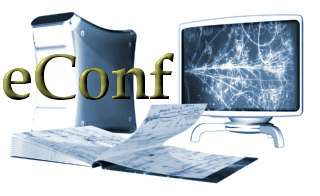
 |
Full-Text Proceeding Instructions and Templates |
| eConf Home |
Purpose
& Philosophy |
Search eConf |
How
to Cite |
For Editors |
For Librarians |
It is not easy to prepare a formal book-length conference proceeding, but the eConf committee would like to make this process as straightforward as possible. To do this, we are supplying LaTeX templates which contain all of the components of a conference proceedings book. In this article, we will explain how to use those components to create a proceedings volume.
Our templates are based on the book style of the 1999 Lepton-Photon Conference (LP99) proceedings. To the extent that you are willing to follow this style, you can make use of the templates straightforwardly. If you prefer to deviate from our style decisions, you are on your own.
Creating a Conference Proceedings Volume Using the LaTeX Templates:
(PS,
PDF) and put it on your Web page well before the
conference. Insist that the authors who will contribute to the proceedings
follow this style. Actually, the file article.tex is
essentially unembellished vanilla LaTeX. Your main problem will be to keep
authors from complicating this with their personal macros, style files, etc.
Encourage them to use the macropackage econfmacros.tex
rather than their own personal macros, since those will inevitably conflict.
Expand the package econfmacros as necessary. Encourage the authors to add
items that should appear in the subject index; the method for doing this is
explained near the top of the file article.tex. Finally, to insure that the
authors are submitting to your correct LaTeX file, encourage them to submit
their papers as eprints to the eprint arXiv. For LP99, papers for
which we obtained the source from the eprint arXiv were typically trivial to
process, while those from authors who submitted their article to us directly
required, on the average, several days of work to bring into a manageable
form.We hope that these materials will allow you to create a beautiful electronic book that will fully replace a commercially published volume. If you have any questions about these instructions, please contact us at mpeskin@slac.stanford.edu.
| eConf Home |
| Purpose & Philosophy | Search
eConf | How to Cite | For
Editors | For Librarians | Site
Contents |
Published by the SLAC National Accelerator Laboratory (operated by Stanford University for the U.S. Department of Energy). All rights reserved. This text may be used and shared in accordance with the fair-use provisions of U.S. copyright law, and it may be archived and redistributed in electronic form, provided that this entire notice, including copyright information, is carried and provided that the document services is notified and no fee is charged for access. Archiving, redistribution, or republication of this text on other terms, in any medium, requires the consent of the Stanford Linear Accelerator Center.
Content updated by: document services